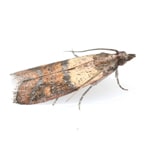Click To Call > (800) 966-7673
Wednesday, February 4, 2015
While baking might be fun, finding pantry pests in the ingredients is not. Be it cigarette beetles, indian meal moths or red flour beetles, these guys can hole-up for months, thriving inside dry, packaged foods and turning your space into their new hangout.

“Pantry pests are attracted to a number of different things that you already have in your home,” says Mark Vanderwerp, manager of education and training at Rose Pest Solutions. “Items from bird seed, cereals and chocolate to dried fruits, pasta and potpourri are just some of the things that lure in these insects.”
While pantry pests can sneak into homes through cracks and crevices or underneath doors, the most common place they come from is actually the grocery or pet store.
“These pests can get into food packaging at a processing plant or on a delivery truck, and eventually, they can make it home with you,” says Mark Sheperdigian, Rose’s vice president of technical services. “Infestation can start with just a few insects or bugs, but over time they will multiply if they’re left alone.”
If pantry pests go unchecked, they can end up posing a number of problems by contaminating food and then spreading to other susceptible products inside a pantry. They will continue to breed, producing several generations in just a single year.
Eggs, larvae and pupa can be tough to see, sometimes making it easy to miss pests that have made their way inside. “It may not be until there are dozens or hundreds of pests that someone realizes there is a problem,” Vanderwerp says. “Looking for hints like visible webbing, from Indian meal moths, or piles of shed skins from beetles are signs of having pantry pests.”
The experts at Rose Pest Solutions offer several ways to prevent pantry pests from taking up residence:
Vanderwerp says one of the easiest ways to correct a pantry pest issue is to dispose of any infested items right away. If they’ve made their way into a valuable, non-food item that cannot be easily replaced, seal it in a bag and put inside the freezer for about a week to kill all the pests.
If any of the above do-it-yourself options have failed, the professionals at Rose Pest Solutions can remedy the problem with an Integrated Pest Management process. A thorough inspection by someone knowledgeable about the pest’s biology and behaviors can often turn up things easily missed by a homeowner. Through sanitation and targeted application of pesticides, pantry pest issues can generally be dealt with in an environmentally-friendly way.
Click here for more information on pantry pests and how to get rid of them.